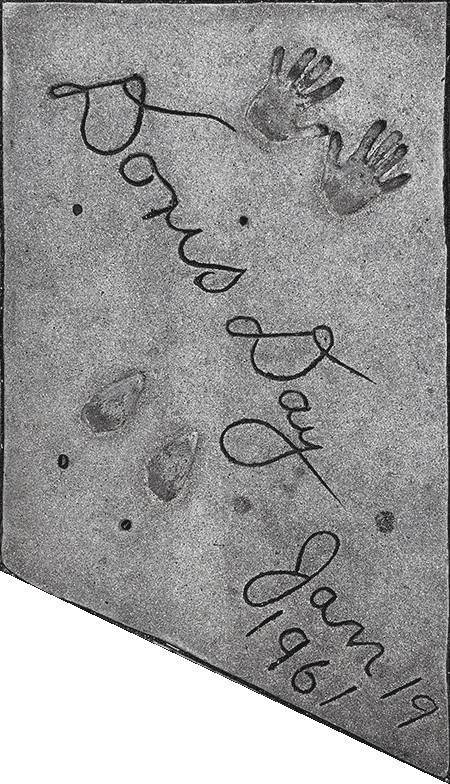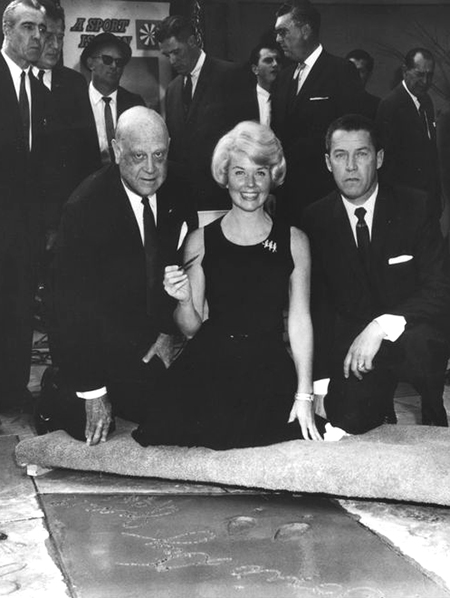 |
 |
|
|
| Doris Day |
 |
| Forecourt Ceremony held on Thursday, January 19, 1961 |
| |
Born: Doris Mary Ann Kappelhof, April 3, 1922, in Cincinnati, Ohio
Age at the time of the ceremony: 38
Died: May 13, 2019, in Carmel, California, age 97
|
| |
Doris Day. Threre's magic in those two words. A luminous presence onscreen, Doris Day brought so much to every film she was in. Gifted with an unmistakable singing voice and an unstoppable pep, Doris Day became the biggest money-maker in Hollywood — her films were hugely popular.
Born to second generation German-Americans, Doris's father was a music teacher and choir leader. Her parents separated when she was a young girl, which was spent taking dancing lessons. By the age of 13, she was performing with dance partner Jerry Doherty on the local scene. Riding home from a gig in October 1937, her car was hit by a train. Doris's right leg was badly injured; she would not dance professionally again.
Encouraged by her mother, the dreamy young Doris was given singing lessons by Grace Racine, who stressed the importance of phrasing a lyric, a quality Doris admired in her favorite singer, Ella Fitzgerald.
Singing on the WLW Radio Cincinnati show Carlin's Carnival and at Charlie Yee's Shanghai Inn brough her to the attention of bandleader Barney Rapp, who was looking for a female vocalist. Doris got the job, which came with a new last name Rapp suggested: Day. Doris married Rapp's trombonist, Al Jorden in 1941, with whom she had a son, Terrence. They would divorce in 1943.
Before long, bandleaders across the country were looking to have Day
perform with them. Her first hit record was "Sentimental Journey" with Les Brown's band in 1945, which became the theme song for all the GI's returning from World War II. That year her recordings with Brown had six top ten hits on the Billboard charts. In 1946, Day married saxophonist George Weidler. They would divorce in 1949.
Day's recording of "Embraceable You" impressed the song's writers, Jule Styne and Sammy Cahn, who suggested that Doris try out for a role in a movie they were writing songs for at Warners called Romance on the High Seas (released in July 1948). Auditioning for legendary hard-ass director Michael Cutriz, she admitted that she was nervous and had no acting experience. Curtiz hired her anyway, saying "She's honest."
Day lit up the Technicolor screen in Romance, singing five songs, including the standard, "It's Magic," and a star was born. Her next film was another Technicolor musical directed by Curtiz, My Dream Is Yours (released in April 1949). The team re-formed for I'll See You in My Dreams (released in December 1951) with Danny Thomas as songwriter Gus Kahn, which became their most successful of all. During this period, Day became the sweetheart of many servicemen fighting in Korea. Also in 1951, Day married former manager for the Andrews Sisters, Martin Melcher, who would co-produce most of Day's films.
Day's next hit film featured her playing a historical character for the first time in the title role of Calamity Jane (released in November 1953). She rounded out her Warner Bros. contract with Lucky Me (released in April 1954), and Young at Heart (released in December 1954).
Doing the unthinkable, Day signed on at M-G-M to appear in a dramatic musical opposite a thuggish James Cagney in Love Me or Leave Me (released in June 1955). The change of pace, with Day appearing in harrowing dramatic scenes with Cagney, caused the film to become her biggest hit so far. The soundtrack album sold like hotcakes.
For Paramount, Day starred with James Stewart in Hitchcock's The Man Who Knew Too Much (released in June 1956), where Day sang her Oscar-winning signature song "Que Sera, Sera (Whatever Will Be Will Be)" Returning to musical comedy, she starred in the film of The Pajama Game (released in August 1957), and got to work with Clark Gable in Teacher's Pet (released in April 1958).
Leaving Paramount for Producer Ross Hunter at Universal, Day scored what might very well be her signature role in Pillow Talk (released in October 1959), with Rock Hudson, who has plenty of fun tormenting Day (playing an interior decorator) on a party line, but she turns tables on him by redecorating his apartment in the most tres ugly style. It made heaps of $$$. Day's next was a fondly-remembered classic, Please Don't Eat the Daisies (released in March 1960), with David Niven.
Ross Hunter put Day through the wringer in Midnight Lace (released in October 1960), with Rex Harrison. Day and Hudson were co-starred again in Lover Come Back (released in December 1961). Day's film with Cary Grant, That Touch of Mink (released in June 1962), became the first film to gross a million bucks at Radio City Music Hall in New York. Day was the top female star for years and years.
The Thrill of It All (released in July 1963) with James Garner was a hit, as was Move Over, Darling (released in December 1963), also with Garner. But the times, they were a'changin' with Day's films becoming incresingly irrelevant to the public and critics. The Glass Bottom Boat (released in June 1966) squeaked by, but a follow-up of sorts Caprice (released in April 1967) flopped. That year, she married Barry Comden, but this union did not last; they divorced in 1981.
Her return to the comic western in The Ballad of Josie (released in February 1968), did okay, while Where Were You When the Lights Went Out? (released in June 1968), was a huge hit. But Day knew it was time. Her last film was With Six You Get Eggroll (released in August 1968).
Day quit the movie business only to find out that her recently decesed husband Martin Melcher and his partner Jerome Rosenthal had squandered all of her money, plunging her deeply into debt. She also found out that she was now contractually obligated to appear on the sitcom The Doris Day Show, which ran for five years on CBS, from 1968 to 1973. She sued Rosenthal in 1969, but had to settle for a pitiful settlement judgement in 1979.
Doris Day ventured out for a television special, The Doris Mary Anne Kappelhoff Special which aired over CBS on March 14,1971, and attempted a talk show on CBN in 1985. That year, Day's legal struggles with Jerome Rosenthal intensified, due to his appeal of the judgements against him. To make a long story short, he was disbarred and died in 2007.
Day remained out of the public eye, living in Carmel-by-the-Sea in California, running the Cypress Inn (a dog-freindly hotel), and
her Doris Day Pet Foundation. She published her autobiography, Doris Day: Her Own Story in 1975.
Retired from the cameras and rarely (if ever) making public appearances, Day spent her final years at her home in Carmel and died after contracting pneumonia. She asked for no funeral, memorial service, or marker. |
|
|
|
|
| |
 |
 |
| Grauman's Chinese Theatre, Hollywood, California. Doris Day Forecourt block. Executed by John Tartaglia, Thursday, January 19, 1961. 31 x 54 inches overall. |
 |
 |
 |
| Grauman's Chinese Theatre, Hollywood, California. Doris Day Forecourt ceremony, Thursday, January 19, 1961. Hollywood Chamber of Commerce president Carl H. Anderson helps Doris Day as she smiles for the cameras, while National Theatres honcho Roy Evans glums along. |
|
|